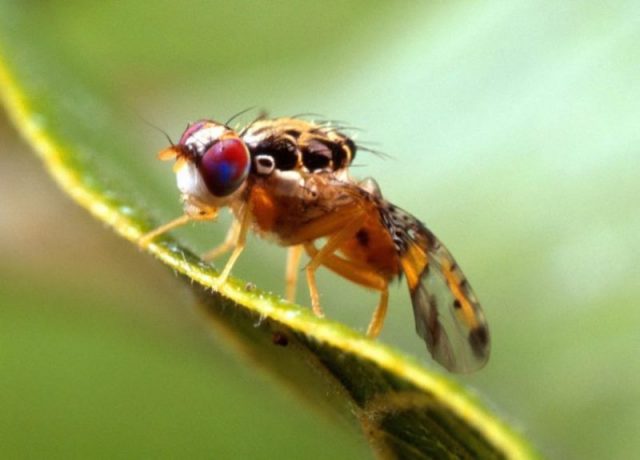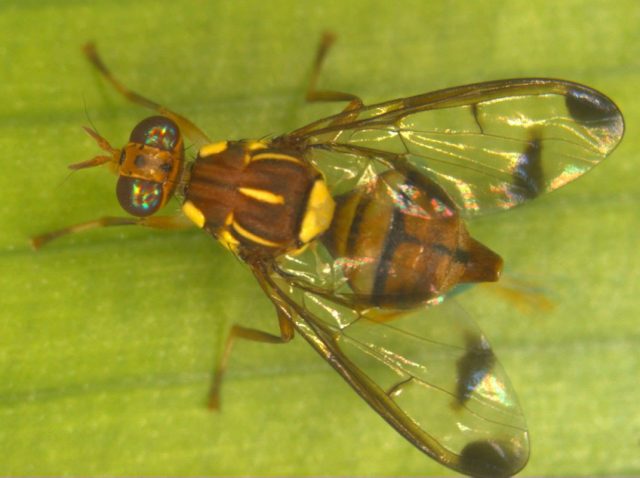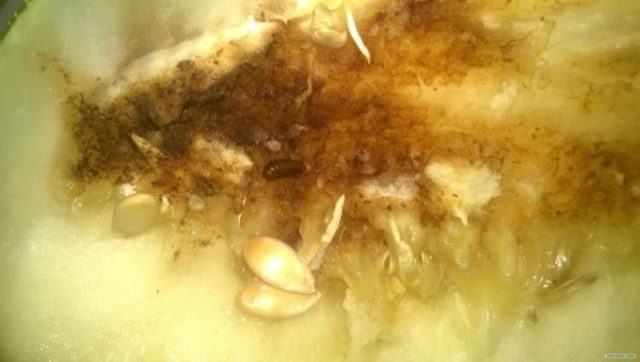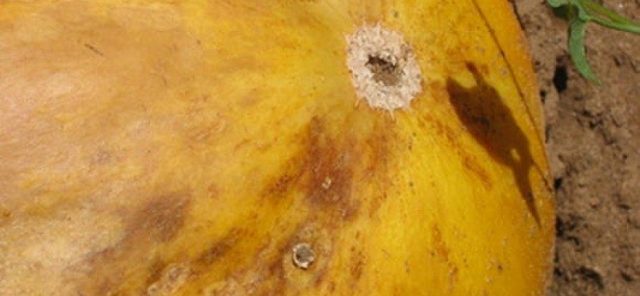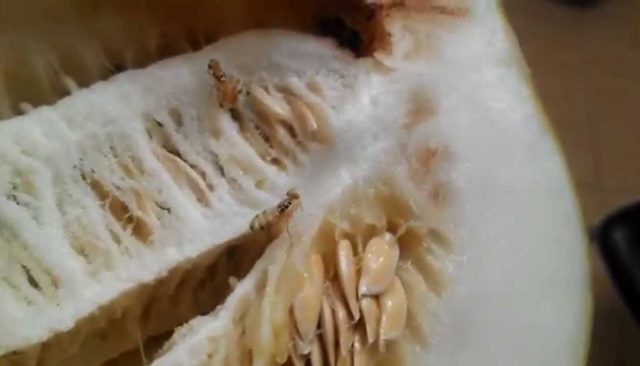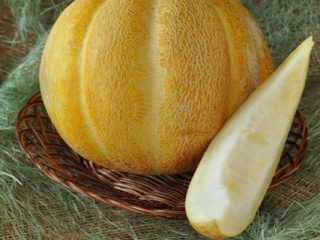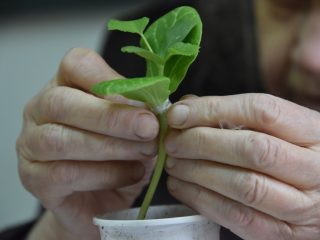Content
Melon fly is one of the most unpleasant pests of any melon crops. The source of food for both larvae and adults (imago) of this insect are plants of the genus pumpkin. This pest has a relatively long life cycle and is capable of reproducing several times during the season. Melon fly infestations are a serious threat to the cultivation of any pumpkin crop.
What does a melon fly look like?
Outwardly, the melon fly is an unremarkable insect, of which many flies in the summer garden. This is a medium-sized fly, predominantly of a pale yellow, less often brownish color. The body length of the insect is about 0.6-0.7 cm, the wingspan is about 0.5 cm.
The head and body of the insect have slightly different shades. The head color is usually brighter. The eyes, located on the edges of the head, are located at a relatively large distance from each other, in contrast to the common fly, in which they practically converge at the top of the head. The insect has a pair of short antennae on its head.
The body of the fly is covered with dense hairs of short length. The wings are of the usual shape for dipterans. Four yellow transverse stripes are visible on them. A photo of a melon fly is shown below.
Insect larvae have the usual shape for flies. Their body is cylindrical. The color of the larvae is off-yellow or off-white. A weakly expressed taper is noticeable: towards the posterior end, the larva can be significantly expanded.
When the larva reaches a size of about 1 cm, pupation occurs. Pupae are dark yellow, almost brown. Their size is about one third smaller than the size of the "adult" larva. It is rare that the pupae of this pest are more than 8 mm.
Life cycle and features of reproduction
This type of fly is extremely prolific. The lifespan of adults is about two months. During this time, one female is able to lay over a hundred eggs.
The first spring years of the melon fly coincides with the formation of the first fruits, although females are capable of reproduction already on the 10th day of their life. They usually lay eggs as soon as the temperature rises above + 20-22 ° C.
Females lay eggs in fruits to a depth of 2-3 mm. Usually one egg is laid in one fruit.
The larvae emerge from the eggs within 48 hours. Leaving the shell, they go deeper into the fruit and begin to actively feed. The larva eats melon juice and any types of fruit tissue: pulp, fiber or seeds.
During the larval stage, up to 3 larva molts occur. The duration of the larval phase of the insect is from 1 to 2 weeks, in autumn - up to 2.5 weeks.
When the time for pupation comes, the larva leaves the fetus and burrows into the ground to a depth of 13-15 cm. The pupa matures for about 3 weeks, after which an adult insect is formed from it, which is ready for reproduction in 1-2 days. In just a season, up to 3 generations of flies can appear.
Which melon does the melon fly lay eggs in?
Young or newly formed fruits, the skin of which is not yet dense enough, are especially vulnerable to flies. Large fruits, as a rule, do not attract flies.
In some cases, infection of large fruits can also occur. This happens if there are deep enough cracks on their skin. If there are many cracks, several different flies can lay eggs in a large fruit.
What does a melon fly eat?
Nutrition of adult insects is carried out by sucking the sap of the plants on which they parasitize. At the same time, the insect feeding scheme is very interesting and depends on the sex of the adult.
Females are able to make small holes on the peel of the fruit or on the shoots, from which after a while the juice begins to stand out, which they drink with the help of the proboscis.
Males do not have such sharp "teeth" on the proboscis to make holes, but they are able to find holes made by females and drink juice from them with the help of their long proboscis.
The nutrition of adult individuals has practically no effect on the life of plants, since the amount of juices they consume is negligible. As a rule, the plant loses much more liquid from various mechanical damage.
The main pest is the melon fly larvae. They damage the fruit from the inside (eating away the pulp and seeds), making it unusable, inhibit the formation of seeds. The larvae can cause a significant decrease in the quality of the crop in any area where they appear.
Habitat
The insect has a wide distribution area. Mostly, these are climatic zones of the subtropics and mild temperate climates.
The African melon fly is widespread in the countries of the Mediterranean basin, in the Caucasus and Central Asia. It is widespread in Turkey, Azerbaijan, Armenia, Georgia, Kazakhstan, Turkmenistan, Kyrgyzstan.
The Middle East also suffers from the population of these flies. They are common in Lebanon, Iran and Iraq, Syria.
Melon fly can be found even in the south of Asia. Here she "terrorizes" the agriculture of India and Pakistan.
The appearance of flies on the territory of Ukraine, Moldova, southern Russia is noted.
Why an insect is dangerous
The main danger of the melon fly is its high fertility. This insect is capable of destroying 70 to 100% of the yield of melons and gourds. In addition to traditional melons, watermelons and pumpkins, this pest can threaten about a hundred other plants.
How to determine the appearance of a pest in the beds
The first signs of fruit parasite infestation is the appearance of many small specks or bumps on them, which form in places where females bite through the skin. The spots and bumps have a characteristic brown tint.
When the larvae enter the active phase of life, more noticeable traces of damage appear - the fruits begin to rot, and this becomes noticeable quite quickly, 4-5 days after the larvae emerge from the eggs.
Can melons contaminated with melon fly be eaten?
Despite the fact that a melon fly does not pose a danger to humans, it is still not worth eating fruits affected by it. A small amount of waste products of the larvae, as well as the flesh damaged by them, cause mild diarrhea.
In more severe cases, there is a slight dehydration of the body.
How to deal with melon fly
If infected fruits are found, they should be plucked and destroyed as soon as possible (it is best to burn them).If the lesion has become massive, it is recommended to treat the plants with an insecticide, for example, Karbofos or Fufanon. Further, it is recommended to repeat the treatment after 2 weeks.
A set of preventive measures
Insect prophylaxis is standard. Since the pupae "ripen" in the soil, weeding and loosening of the soil should be carried out regularly in order to extract the pupae to the surface, where they will be destroyed by birds or other insects.
In some regions of the Caucasus, an original method is used - burying fruits that have reached 3-5 cm in diameter into the ground, then melons are formed under a layer of soil and flies cannot reach them. A variant of such prevention is to cover the fruits in the beds with a layer of wood ash.
Chemical prevention of melons is also used. For these purposes, Zenith products are used (in concentrations of 0.25 liters per 10 liters of water) or Rapier (2 liters of solution per 1 ha). Spraying with drugs is carried out twice a season. Plants undergo the first treatment at the beginning of spring, immediately after the formation of the first leaves, the second treatment is carried out after the formation of the first loops.
In addition, the use of insecticides such as Decis or Arrivo is recommended as a preventive measure. When using these drugs, you must strictly follow the instructions of the instructions.
An effective remedy is planting repelling plants - castor oil plants or calendula - near melons.
In some cases, filling melons with deterrent agents - ash, tobacco dust and others helps.
It is also recommended to plant the plants earlier, so that the fruits have time to form and "overgrow" with a thick skin before the first summer of melon flies.
Conclusion
Melon fly is a serious pest of most melon crops. Throughout the distribution area, a struggle is being waged with it with varying success, and a person does not always win in it. The combination of the correct agronomy of melons with the use of chemicals is the only effective method for successfully combating this pest.
